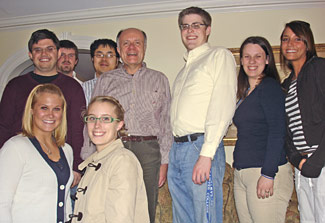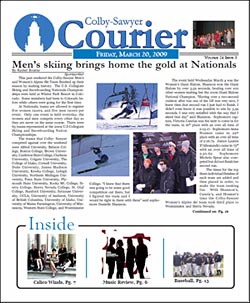
Courier Staff Carries on Tradition While Learning from the Pros
In this tough economy, each day brings word of another business filing for bankruptcy, and the industry that is accustomed to providing the news has more and more found itself in the news. Newspapers around the country have been forced to cut pages and change tactics in order to keep printing; the New York Times recently began putting ads on the front page and the Portland Press Herald/Maine Sunday Telegram has cut its content drastically. The phenomenon has hit papers hard, including many college newspapers, but Colby-Sawyer's Courier is so far avoiding the crunch.
Turning Back the Pages: A Look at Colby-Sawyer Publications
Colby-Sawyer College, previously known as Colby Academy and Colby Junior College, has had several newspapers, including two larger publications – the Kearsarge Beacon and the Courier - and two smaller ones called This Week and The Voice.
The Kearsarge Beacon was organized by Colby Junior College students in 1942 and aimed to “present a complete and accurate record of life in the student community.” The paper raised funds from subscriptions to pay for printing costs. Jobs on the Kearsarge Beacon ranged from reporters to assistants to editors, setting itself up in much the same way that large papers do.
Students founded the Courier in the early 1960s, and since then it has been one of the college's major sources of news on and off campus. The paper began as a weekly that focused on keeping students informed of national, international and local affairs. Courier staff even attended conferences held by the United States Press Association in order to improve the quality and interest in the paper.
In addition to the Kearsarge Beacon and the Courier, Colby-Sawyer had two smaller publications. One of the earliest on record was The Voice, which began in the early 1900s when the institution was still Colby Academy. The other publication is one that students still receive, called This Week. It began as a weekly paper that was put into the mailboxes of students and featured sports articles, letters to the editor, and a monthly calendar of campus events. These days, students receive This Week in the form of an e-mail that informs them of events, minus the longer stories.
What is the Courier today?
The Courier began as a weekly paper focused on delivering the issues to students, and has stayed true to that mission - the 16-page, bi-weekly, student -run paper with student-generated content still strives to communicate the issues that affect college students.
The newspaper is considered a club, and its membership fluxuates from year to year. The staff currently consists of around 20 writers, photographers and editors, and is overseen by Donna Berghorn, associate professor of Humanities.
“What draws people to the Courier is that, first, everyone wants to see their name in print,” says Editor in Chief Sean Ahern '09. “But second, and what I think really draws students, is our big staff. We are all very friendly and know what we are doing. Surprisingly, we are a lot bigger than many staffs in the country.”

The New York Times Conference
The Courier staff takes the responsibility of running a newspaper seriously, and to learn more about their craft, each year two editors attend a conference at the New York Times' offices. This year the lucky students were Ashley Finethy '11 and Jonathan Pappalardo '10. Accompanied by Professor Berghorn, they had the opportunity to listen to speakers discuss the state of newspapers across the country and other issues, such as dealing with the internet in publication.
“The Times staff was helpful and insightful; they were really honest and let us know how they deal with their problems,” said Finethy. “They gave sort of a template for dealing with many of the problems a college paper encounters.”
Also attending the conference were students representing college newspapers from around the country. The Colby-Sawyer representatives found that compared with their colleagues, the Courier “blows a majority of the papers represented there out of the water,” according to Finethy.
Finethy talked to one editor from another paper who was shocked to hear how large the Courier staff is, and who commented that as the editor of her college's newspaper she has to write six stories herself just to fill a few pages because she is so understaffed.
“I am really grateful that we have enough writers to assign one article per person and still have a good-sized paper,” said Finethy.
Looking to the Future
Based on the dwindling page counts of many of the nation's papers, it seems fair to say that newspapers are a dying breed, but one that could be revived online in a variety of ways. Many publications now supplement print articles with online stories, while a few, like the Christian Science Monitor, have moved entirely to the web. Others make all of their stories available online, something that the Courier may also move toward.
“I like having a newspaper in my hands,” said Ahern. “But that's not to say that there isn't something to be said for technology.”
Right now, the Courier is available on the Colby-Sawyer website as a PDF, but according to Ahern, in the future students may be able to find it online as a blog or a website; they would use the money traditionally spent on printing costs to purchase server space and a domain name. Current thinking envisions the online paper as a sort of blog run by the students with the ability to publish stories on a daily basis.

A Call for Writers
“Anyone and everyone should join this club. If you have an opinion, or something that is bothering you and know other people who feel the same way, come join us,” says Ahern. “Strong writers are great, but we can always help new writers get into the groove of strong news writing. Anyone who wants to make an impact on how their college community moves forward should join.”
While the futures of many newspapers look uncertain, the Courier seems to be standing strong. It has not only become a news outlet, but an important form of expression for students. The writers work hard to put out articles driven by student interest.
“The Courier is important to the college community because without it, there would be no voice for the students,” says Ahern.
To paraphrase Joseph Conrad, the Courier is a voice that will not be silenced – not as long as there are students dedicated to the mission of the newspaper.
-Amber Cronin '11



